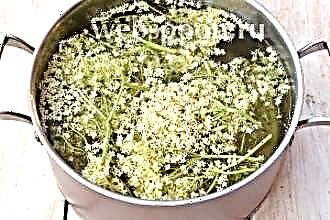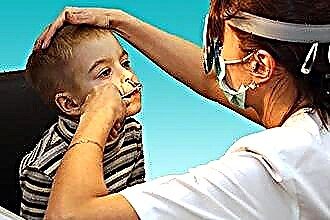Chronic tracheitis is a sluggish infectious inflammation of the trachea, which in most cases is caused by pathogenic bacteria. A common cause of the development of pathology is delayed or inadequate treatment of acute inflammation in the respiratory tract. Exacerbations can be provoked by colds, emphysema, smoking, vitamin deficiency, chronic rhinitis, hypothermia, etc.
With the progression of the infection, the lower parts of the respiratory tract are involved in the pathological processes - the larynx, bronchi and lungs. A hacking dry cough is a typical sign of the development of the disease. Diagnosis of chronic tracheitis includes microbiological examination of a throat swab, laryngotracheoscopy, and chest x-ray. Therapy is carried out with antibiotics, antihistamines, mucolytic, expectorant and anti-inflammatory drugs.
Forms of chronic tracheitis
 The symptoms of chronic tracheitis in adults are determined by the form of the disease. The exacerbation of inflammatory processes is favored by a decrease in the reactivity of the body, as well as the presence of foci of sluggish inflammation in the respiratory mucosa. Depending on the characteristics of changes in the morphological structure of tissues in the trachea, two forms of the disease are distinguished:
The symptoms of chronic tracheitis in adults are determined by the form of the disease. The exacerbation of inflammatory processes is favored by a decrease in the reactivity of the body, as well as the presence of foci of sluggish inflammation in the respiratory mucosa. Depending on the characteristics of changes in the morphological structure of tissues in the trachea, two forms of the disease are distinguished:
- hypertrophic - with inflammation of the trachea, the blood vessels greatly expand, as a result of which the mucous membrane acquires a bright red color and thickens; coughing fits are accompanied by the separation of an abundant amount of sputum with impurities of pus;
- atrophic - characterized by thinning of the walls of the trachea and the formation of dry crusts on the surface of the mucous membrane; morphological changes in soft tissues lead to drying out of the ciliated epithelium and, as a consequence, the appearance of an unproductive spastic cough.
It should be noted that in chronic tracheitis, the body temperature rises only to subfebrile levels, i.e. maximum up to 37.5 ° C.
The frequency of attacks increases at night and in the morning after waking up. The hypertrophic form of the disease is dangerous with complications, especially laryngeal stenosis. Due to the increase in the volume of the mucous membrane, the lumen in the airways is greatly narrowed. In this regard, symptoms of respiratory failure appear. If the disease is not treated, subsequently it can provoke an attack of suffocation and even death.
Clinical picture
How does chronic tracheitis manifest? The disease is characterized by a spastic cough that occurs with a deep breath, laughing, screaming or crying. After an attack, a burning sensation or even pain appears in the chest area, which can radiate to the area between the shoulder blades. Other characteristic manifestations of sluggish tracheal inflammation include:
- subfebrile condition;
- labored breathing;
- discomfort when swallowing;
- decreased appetite;
- regional lymphadenitis;
- Barking cough.
Symptoms of atrophic tracheitis differ from the manifestations of the hypertrophic form of the disease only by the absence of sputum during coughing.
Signs of intoxication with sluggish tracheitis are practically not manifested, but due to constant spastic cough, patients may complain of headaches, nausea and weakness. As the infection progresses, small bronchioles can be affected, therefore, bronchiolitis is diagnosed in about 64% of patients along with tracheitis.
General recommendations
Can chronic tracheitis be cured? A persistent cough and low-grade fever are good reasons for seeking help from a pulmonologist or an ENT doctor. After the examination, the specialist will prescribe adequate treatment for chronic inflammation, which will be accompanied by the intake of drugs of etiotropic and symptomatic action.
During the period of exacerbation of the disease, treatment is carried out taking into account the following rules:
- compliance with bed rest;
- sparing food (avoiding fried and spicy foods);
- drinking alkaline drinks.
During the treatment of tracheitis, it is not recommended to visit baths or saunas, since an increase in temperature only stimulates the reproduction of bacterial flora in the trachea.
Proper patient care is the key to successful treatment of sluggish inflammation in the respiratory system. Compliance with the drinking regime allows not only to quickly cleanse the body of toxic substances, but also to create unfavorable conditions in the laryngopharynx for the reproduction of pathogenic microbes. As an alkaline drink, it is recommended to use Borjomi, Essentuki, warm milk with honey, herbal teas, etc.
Features of drug treatment
 What drugs should be used to treat chronic tracheitis? Treatment should be comprehensive, therefore, physiotherapeutic procedures, as well as pharmacy antibacterial and anti-inflammatory drugs, are included in the therapy regimen. The patient is often prescribed the following types of pharmaceutical preparations:
What drugs should be used to treat chronic tracheitis? Treatment should be comprehensive, therefore, physiotherapeutic procedures, as well as pharmacy antibacterial and anti-inflammatory drugs, are included in the therapy regimen. The patient is often prescribed the following types of pharmaceutical preparations:
- antitussives;
- mucolytic;
- antiallergic;
- antiseptic;
- expectorant;
- antimicrobial;
- immunostimulating.
In the absence of serious complications, therapy is carried out on an outpatient basis. To speed up recovery, it is recommended to resort to nebulizer therapy, which has practically no contraindications. Compressor and ultrasonic inhalers can be used even when the temperature rises, which cannot be said about steam inhalation.
In addition, tracheitis in adults is successfully treated with folk remedies that have a pronounced anti-inflammatory effect. Gargling with broths based on licorice root, thermopsis and thyme allows you to stop spastic cough and reduce the severity of inflammation in the airways. Inhalations with chamomile, sage and eucalyptus are considered no less effective.
Antibacterial drugs
Treatment of chronic tracheitis should be accompanied by the use of drugs that help eliminate the cause of the disease - a bacterial infection. It is pathogenic microbes that cause a sluggish inflammation of the respiratory system, which leads to a change in the structure of the mucous membranes and complications. To destroy staphylococci and streptococci, which most often provoke chronic tracheitis, you can use the following antibiotics:
| Group of drugs | Description | Name of drugs |
|---|---|---|
| fluoroquinolone | destroys staphylococci, Escherichia coli, streptococci and Klebsiella; prevents the development of purulent-necrotic processes in tissues | "Abaktal" |
| macrolide | destroys gram-positive microbes, relieves purulent inflammation of the trachea and other parts of the respiratory tract | Josamycin |
| cephalosporin | destroys the cellular structures of enterobacteria, staphylococci, pneumococci, etc.; eliminates inflammation and accelerates the resorption of infiltrates | "Azaran" |
| penicillin | inhibits the reproduction of aerobic and anaerobic microbes, prevents the development of purulent-infectious processes in the ENT organs | "Amoxiclav" |
| polypeptide topical antibiotic | prevents the reproduction of pyogenic microbes, yeast-like fungi and pneumococci; has pronounced antiphlogistic (anti-inflammatory) properties | "Fusafungin" |
It is undesirable to take cephalosporins and fluoroquinolones during pregnancy without a doctor's recommendation, as this can lead to allergic reactions.
Depending on the severity of the disease and the dynamics of recovery, the course of antimicrobial therapy lasts 7-20 days. In the absence of a positive effect, drugs are replaced with stronger antibiotics.
Antitussives
How is dry spastic cough treated? With atrophic tracheitis, antitussives are included in the complex treatment regimen. Some of them suppress the activity of cough centers, others - reduce the sensitivity of cough receptors in the respiratory tract. Taking medications helps to stop coughing, as a result of which the course of chronic tracheitis is facilitated.
With an infectious lesion of the trachea, antitussives are usually used in the form of syrups or tablets:
- "Butamirat";
- "Prenoxindiosinr";
- Glaucine;
- "Codeine";
- Libeksin;
- "Sedotussin".
Antitussives can only be used for unproductive coughs!
Do not use drugs that suppress the cough reflex when separating sputum. The accumulation of mucus in the lower respiratory tract can cause inflammation and the development of bronchitis. In addition, irrational medication often causes side reactions - shortness of breath, drowsiness, dizziness and nausea. This is due to the fact that the composition of drugs includes components that affect the functioning of the respiratory centers in the brain. Therefore, during treatment, the dosage recommended by the doctor must be strictly observed.
Expectorants
To quickly eliminate the cough syndrome and accelerate the evacuation of mucus from the respiratory tract, you can take antitussives. Depending on the principle of action, the following groups of drugs are distinguished:
- mucolytics are secretolytic drugs that reduce the viscosity of bronchial secretions, as a result of which the process of its separation from the walls of the respiratory tract is accelerated;
- expectorants - means of secretomotor action that stimulate the activity of the cough centers and smooth muscles of the respiratory tract, as a result of which the excretion of sputum from the respiratory system is accelerated.
 With a dry cough, the patient is first prescribed secretolytics, and then - expectorant drugs. Sluggish tracheitis in adults can be treated with the following drugs:
With a dry cough, the patient is first prescribed secretolytics, and then - expectorant drugs. Sluggish tracheitis in adults can be treated with the following drugs:
- Ambroxol;
- Broncatar;
- "Gedelix";
- "Doctor Mom";
- "Mukodin";
- "Termopsol";
- "Tussamag";
- "Fluditek".
The advantage of expectorants is that they not only eliminate coughing, but also promote the elimination of mucus, which is a favorable environment for the growth of microbes. Taking mucolytics relieves the symptoms of the disease and, at the same time, helps to reduce the amount of pathogenic agents in the tracheal mucosa, as a result of which recovery is accelerated.
Nebulizer inhalation
Inhalation is the best method for local treatment of respiratory diseases, which has a beneficial effect on the condition of the mucous membranes and increases local immunity. When using nebulizers, the medicinal solution is converted into an aerosol, which penetrates directly into the foci of inflammation. Regular inhalation increases the concentration of drug components in soft tissues, thereby enhancing their therapeutic effect. Reklama: Pakabukai, vyriškos ir vaikiškos grandinėlės, auskarai, apyrankės ir sidabriniai žiedai
Inhalation should not be done on a full stomach, as this can provoke nausea and even vomiting.
When using nebulizers, experts recommend using local antibiotics, antiseptics and mucolytics as medicines:
- "Lazolvan";
- "Bioparox";
- Sumamed;
- Chlorophyllipt;
- Ingalipt;
- "ACC";
- "Fluimucil".
The average duration of one session is 10 minutes. To achieve positive results, you need to make at least 4 inhalations a day for two weeks. Premature discontinuation of therapy can provoke a relapse of inflammation in the airways and a resumption of coughing.



